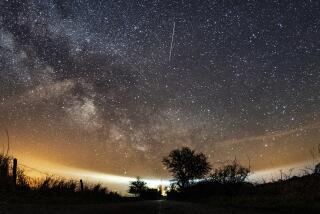Orionid meteor shower created by Halley’s Comet peaks this week. Here’s how to catch a glimpse

- Share via
Goodness, gracious, great balls of fire! California’s night sky will be lit up this week.
The annual Orionid meteor shower will peak early morning Friday.
Orionids, named after the constellation Orion because they appear near the cluster of stars that make up Orion’s Belt, are fragments of space debris and dust trails from Halley’s Comet, according to NASA. Earth’s last brush with Halley’s Comet was in 1986 and because the comet orbits Earth only once every 76 years, it won’t be seen again until 2061.
Each time Halley’s Comet returns to our inner solar system, however, it scatters leftover comet particles and bits of broken asteroid, NASA researchers say. Each year, Earth crosses through these trails of debris, resulting in two annual meteor showers: the Aquarids in May and the Orionids in mid- to late October.
Let’s dive into the cosmos in celebration of the Perseid meteor shower, which will peak Friday and Saturday.
Edwin C. Krupp, director of the Griffith Observatory, said the best spots to get a clear view are areas as far away as possible from major cities and heavy light pollution, which means Southern California observers hoping to catch a glimpse of Friday’s shower may need to make travel plans away from the city.
“If you get into the mountains or out to the east — Palm Springs, Joshua [Tree National Park], Yucca Valley — once you’re well away from a really high concentration of city light, then you’ve got a chance,” Krupp said. “If you see the stars and they dazzle you, you know you’re far enough.”
The best time to view the Orionid meteor shower will be between 4:40 and 5:40 a.m., according to the Griffith Observatory’s website.
Krupp recommends camping out at least 10 to 15 minutes before the predicted time window of when the shower starts to give your eyes a chance to adjust to the night sky. The best area to keep an eye on, he said, is roughly halfway up the sky to the east, near Orion, one of the sky’s most notable constellations.
Observers should keep an eye for “a flash of light, relatively bright compared to anything else that you’re seeing up there for that moment,” Krupp said. It will last for just a brief moment, he said, but it will leave behind what looks like a “trail of light,” which is actually the meteor burning through the atmosphere’s air.
“When you see one, you might just first see a bright spot of light that is just momentarily visible before it changes into almost like a quick line of light that quickly fades,” Krupp said. “So it’s almost like a match, in terms of its brevity, that brightens up and shoots a short way across the sky and then disappears.”
More to Read
Sign up for Essential California
The most important California stories and recommendations in your inbox every morning.
You may occasionally receive promotional content from the Los Angeles Times.















